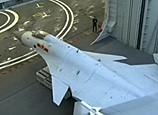
WASHINGTON, April 23 (Xinhua) -- U.S. astronomers said on Tuesday that a recently-discovered, highly active comet will skim 1.2 million kilometers above the Sun's surface on Nov. 28 and has the potential to be readily visible from the Earth.
The comet, C/2012 S1 (ISON), is highly unusual in that it comes to the inner solar system for the first time and will skirt around the Sun within less than two solar radii from the Sun's surface, according to researchers at the Planetary Science Institute in the United States.
"As a first-time visitor to the inner solar system, Comet C/ ISON provides astronomers (with) a rare opportunity to study a fresh comet preserved since the formation of the solar system," said research scientist Li Jianyang, who led a team that imaged the comet, in a statement.
"The expected high brightness of the comet as it nears the Sun allows for many important measurements that are impossible for most other fresh comets," Li added.
Astronomers believe that the comet will get dramatically brighter as it swings around the sun in late November, with Li claiming that the comet could shine brighter than the full moon.
Comet C/ISON was discovered in September 2012 when it was farther away from the Sun than Jupiter, and was already active at such a great distance. This is distinct from most other sungrazers -- comets that pass extremely close to the Sun -- that are only discovered and remain visible for several hours nearest the Sun.
The comet was imaged with the Hubble Space Telescope on April 10 when it was slightly closer than Jupiter: 621 million kilometers from the Sun and 634 million kilometers from the Earth.
Li's team is using these images to measure the activity level of this comet and determine the size of the nucleus, in a bid to predict the comet's activity when it passes perihelion, or the closest point to the Sun, later this year.
Preliminary measurements from the Hubble images suggest that the nucleus, or the solid, icy body at the center of a comet, is no larger than 5 or 6 kilometers across. This is remarkably small considering the high level of activity observed in the comet so far.
The comet is active as sunlight warms the surface and causes frozen volatiles to sublimate. The comet's dusty coma, or head of the comet, is currently approximately 5,000 kilometers across, or 1.2 times the width of Australia, and its dust tail extends more than 92,000 kilometers.
The researchers said that more careful analysis is currently under way to improve these measurements and to predict the possible outcome of the sungrazing perihelion passage of this comet.
















 China’s weekly story
China’s weekly story
(2013.4.13-4.19)


![]()
